#anatomical specimens
Text

hottest babe at the oddities convention (they/them only)
#SYLKYS0F7#syltag#insects#bugs#anatomical specimens#oddities#<< for ppl sensitive to these topics#oh#gore#i guess too?? just in case#BUT YEAH MAKING U LOOK AT MY FURSONY
38 notes
·
View notes
Text
So I’m going to highlight something I’m not sure people who like skeletons and curiosities think about often:
the human skeletal remains you see for sale in oddities shops were invariably grave-robbed.
I worked with human remains in an academic research context in the US for more than a decade. One of the first things I tried to teach my students was respect for the remains in our collections, not only because they were people, deserving of dignity in their death, but also because most of the skeletal remains in academic teaching collections were not donated voluntarily. In most cases, we have no idea exactly where they came from or to whom they belonged.
Historically, there has been a huge international trade in human skeletal remains for teaching medical students. The trade reached its peak in the 19th Century and continued for much of the 20th, and while ostensibly the practice was banned in India in 1985, it does still exist illegally. In the US and Europe, most of the remains in teaching collections were sourced from India through bone traders. Bone traders were (are) lower caste people charged with disposing of human remains—often by cremation, but also by interring in graves—but instead of doing so, sold the remains on to medical schools in the US/Europe through the intermediary of anatomical and medical supply companies. These anatomical specimens are the remains of people who were, unknowingly and without consent of their loved ones, denied their humanity in death to satisfy the appetite of the West for anatomical specimens, despite the remains of their own people being considered largely sacrosanct.
Which leads me to my next point: this practice originated under British Colonialism in India. I hope I don’t need to draw this point out, but objectification of these remains by medical students and researchers is a furtherance of the Western colonial project and othering of people of colour. As medical students, we’re trained to divorce ourselves emotionally from the remains we learn from in the name of professionalism. Medicine can often be confronting, and it serves patients and doctors alike to be able to continue working calmly and objectively in the face of those challenges. But in a world where empires and scientific disciplines have been (and continue to be) built on a legacy of scientific racism and dehumanisation, it behooves us to consider exactly how those teaching specimens were acquired—and how they came to be for sale.
Any human skeleton or human bones you see for sale in oddity stores are invariably retired teaching specimens, or were otherwise originally purchased through an anatomical specimen supply company that leveraged bone traders for acquiring their wares. In other words, those remains were grave-robbed, or stolen from funeral pyres and morgues. It is vanishingly unlikely that they are remains of known, ethically-sourced provenance like informed donation. If they were, they would not have been relinquished to the general public to be sold for profit. There would be contractual obligations that dictate how those remains would be managed once they need to be retired from teaching/decommissioned.
Please keep this in mind when you see human remains for sale in oddity shops. Buy plastic or ceramic teaching models instead. Don’t unwittingly continue creating a market for stolen human remains.
#personal#if you’re wondering what should be done with the remains if we can’t teach with them the answer is inter and memorialise them#universities and medical schools need to make a concerted effort to shift their reliance on these remains towards intentionally constructed#teaching collections of known and ethical provenance#this is a hugely expensive time-consuming and complicated enterprise#but to be honest I’m not sure I like what it says about most institutions that theyd want to do it on the cheap#I also did a lot of work back in the day in repatriation of indigenous remains in museum contexts and I will tell you:#if the institution can’t tell you where they came from or to whom the remains belonged#they likely aren’t there voluntarily#medicine#human skeleton#anatomical specimens#oddities#scientific racism#Calcutta bone trade#osteology#anatomy#anatomical study
3 notes
·
View notes
Text

46 notes
·
View notes
Text
this post is a thank you to the mhy staff who made chest harness luke possible. the shading of the folds on his shirt is truly. detailed.

and by that i mean you can literally see the outline of the key under his shirt !!! i wasn't looking anywhere else, i swear!!!!!!

#literally no reason to make this an entire post but to beg for an outfit where luke is in his agent clothes#dont be afraid mhy give us chest harness luke outfit#let us touch the harness.#im really just thinking thoughts about luke pearce rn#please excuse me#(gawks at how meticulously they shaded the folds of fabric to outline his uhm ahem pectoralis major)#from an anatomical standpoint ofc#what a fine specimen
153 notes
·
View notes
Text
Sketchbook nonsense.
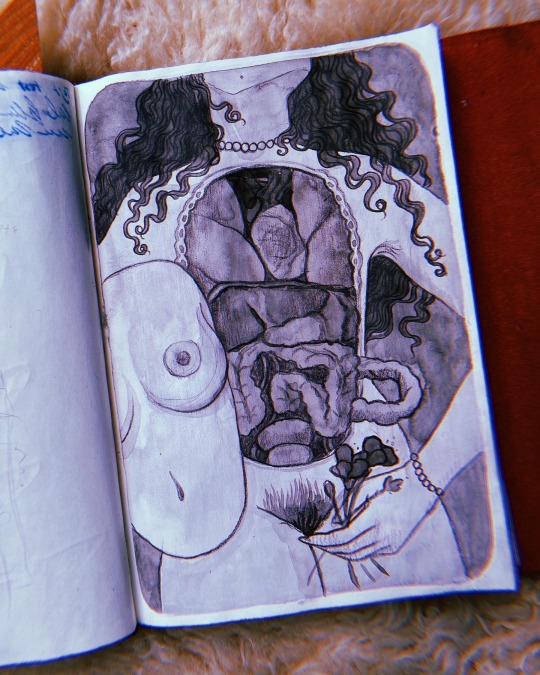
Precious collected objects of curiosity.
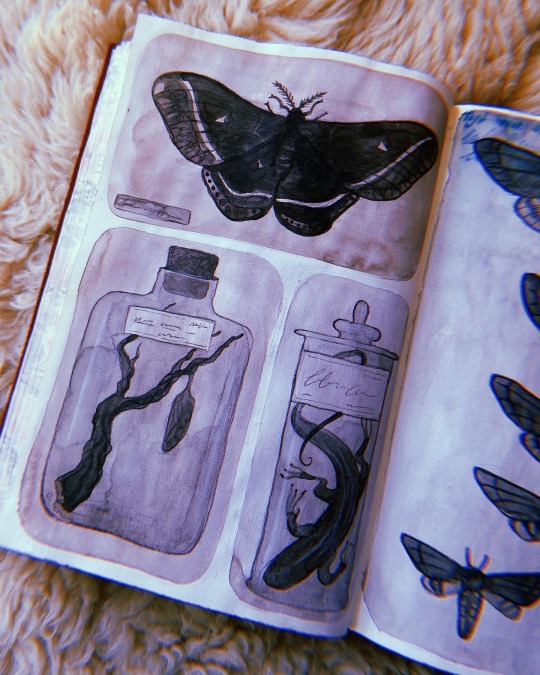
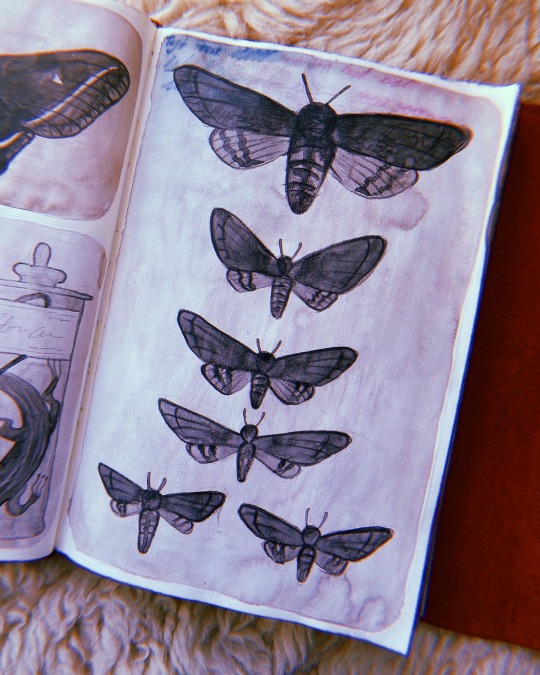
(Preliminary sketchbook exploration for my huge Anatomical Venus silk scarf.)
#Anatomical Venus#anatomy#cabinet of curiosities#pinned specimens#illustration#art#sketchbook#watercolor
186 notes
·
View notes
Text



They were throwing away a bunch of "used" (??) sheep hearts at work so naturally I rescued one. Just the romantic in me 🥰
#sheep heart#preserved heart#preserved specimen#preserved specimens#mad science#heart#anatomical heart#science#biology
13 notes
·
View notes
Text
Just bought another wet specimen from Etsy oh noooooooooooooooooooooooooooooooooooooooooooooooooooooooooooooooooooooooooooooooooooooooo
#this one is so cool and unique#i debated whether or not to buy it for a few days but someone else had it in their cart and I panicked#it's a veterinary specimen of a kitten (failure to thrive#passed away naturally from a lung issue or blockage)#and it's BISECTED like one half of it is still normal and covered in fur#BUT THE OTHER SIDE has an opening into the chest cavity so you can see the lungs in the rib cage and the other lower organs too#and the head omg there's a straight clean cut down the front of the face and the other side of the head is bare bones skull#it's legitimately one of the coolest anatomical examples I've ever seen preserved and I'm vibrating with excitement#can't wait to add this sweet baby kitten to my collection!!#i also have a leopard gecko specimen (his name is Barney)#he dropped his tail shortly before he passed away due to old age and they preserved his tail alongside his body in the jar!!!#another very neat anatomical display ahhhh#i know it's morbid but I love giving these creatures a second 'life' in death
2 notes
·
View notes
Text
Girl who is very into transgressive art and breaking down societal taboos through visual systems and yet is terrified to watch a film showing an autopsy on their own
#I’m ok with still images and phyiscal anatomical specimens it’s just I think the act of processing a body that makes me need moral support#like watching it happen as an event in time#hhhhrh<- that’s how it makes me feel#I wish I didn’t have limits with punches I can roll with I want my heart to be open to every experience on earth no matter how unpleasant
3 notes
·
View notes
Photo



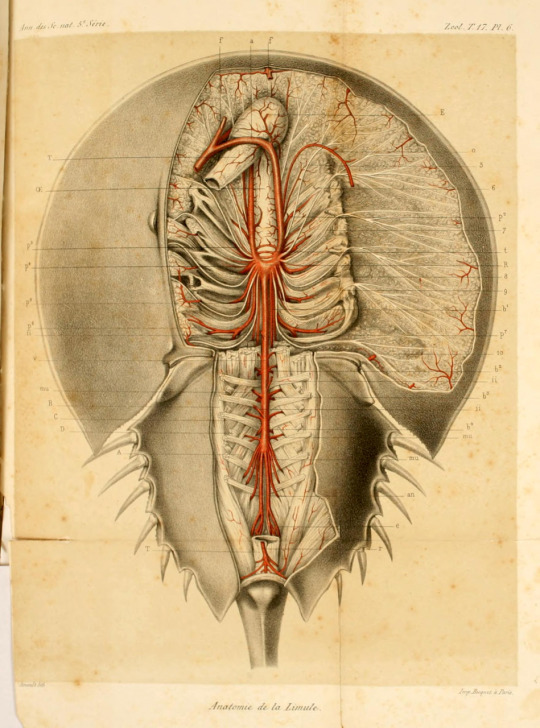



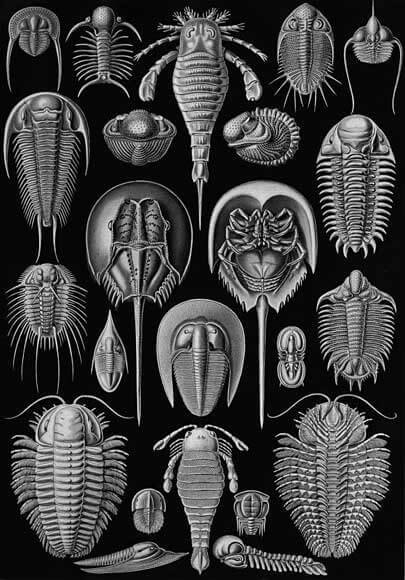

Horseshoe crabs: Limulus polyphemus, Tachypleus tridentatus
eggs
Cancer of Moluccas (Crabs of the Moluccan [Spice] Islands) - in August Basilius and Michael Rupertus Fasciculus rariorum Book (Petrus Iselburg drew them alive) - 1616 - in Herzog August Library in Wolfenbüttel, Germany
Selected Delights of Nature from Natural History Cabinet - Georg Wolfgang Knorr - 1766-1767
Recherches sur l'anatomie des Limules (Horseshoe Crab Anatomy Research) - Paris - 1873
Tachypleus tridentatus - Fauna japonica - vol.1 - 1833
The Horseshoe crab - Limulus polyphemus from the John Reeves Collection
horseshoe crab anatomy - nervous system
Ernst Haeckel - Athropods - from Kunstformen der Natur (Art Forms of Nature) published in 1904
Charlie’s Horseshoe Crab costume - 2018 Halloween Costume Contest - Kimberly, the 'Horseshoe Crab' costume creator writes: Charlie, 4 years old, loves ocean animals and decided she wanted to be a horseshoe crab for Halloween. Her Dad made the costume using EVA foam exercise mats (using a heat gun to mold/sculpt the right shape), contact cement, and a Plasti-dip base coast with a spray paint finish. Spandex was used for the joints between the segments, so she can get around pretty well. The costume is put on using a handmade vest with Velcro straps for easy on and off.
June 20 is International Horseshoe Crab Day
#photography by others#horseshoe crab#eggs#anatomical specimen#anatomical drawing#natural history#Limulus#Tachypleus#costume#prints#art by others#other's artwork
23 notes
·
View notes
Text


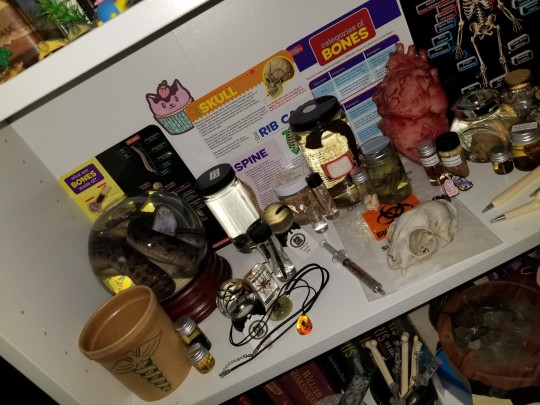
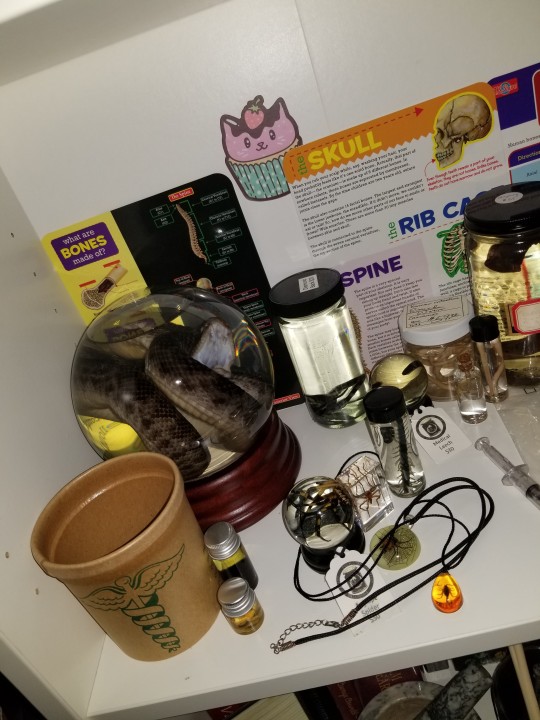
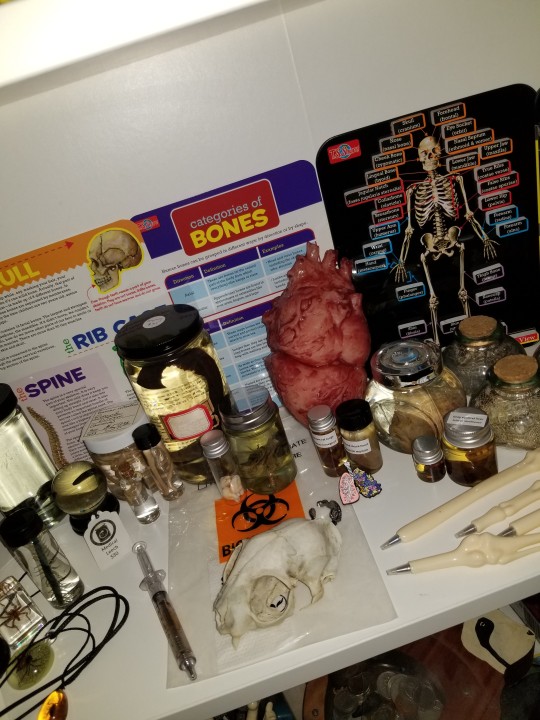
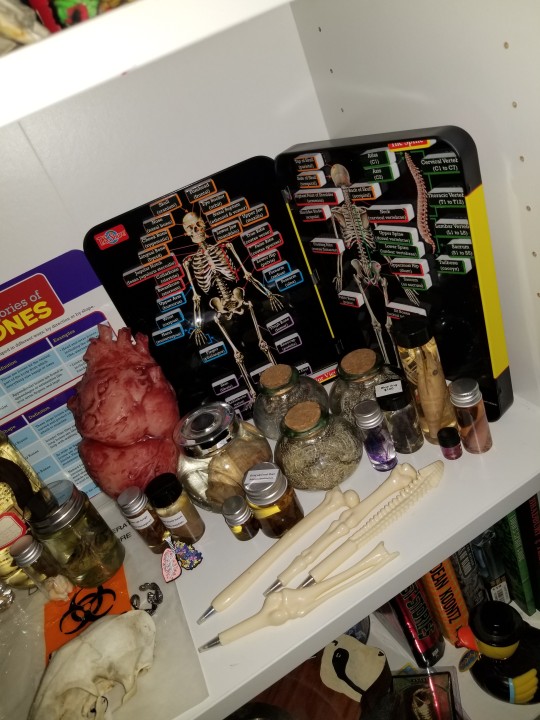
You know what this is and what I am. I'd say my first self is complete. Marvelous. Now, I must make room for a second.
What lies on here?
Bone pens
A 1951 medical specimen collection cup
A raccoon skull
A biohazard bag
A anatomical heart squish display
A magnetic diagram over the human skeleton and other laminated papers
Lungs enamel pin
Rattlesnake ring
Syringe pen
Golden Ord Spiny Spider necklace
Spider in resin
Deathwalker scorpion necklace
Mojave Rattlesnake
Baby Diamondback rattlesnake
Blje Centipede
Aprigope spider
Mouse pinky
Fuzzy bear Caterpillar
Medical Leech
3 roundworms (human, dog, and pig intestine)
Sea Lamprey
My wisdom teeth
House Sparrow Chick
Brown Rat Lungs
Striped Skunk heart
Raccoon heart
Brown rat heart
Gray squirrel liver
Alaskan Prawn
Diaphonized Prawn
Octopus tentacle
Baby squid
Blue ring baby octopus
3 jars of the shed skin of each of my snakes.
💜
#mad science#mad scientist#sciencecore#gothic horror#pov mad scientist#wet specimens#wet specimen#what would you do for wet specimens#mad sciences#mad scientists#tw bones#tw dead things#tw dead animal#tw dead animals#tw anatomical heart#doctor#wisdom teeth#tw teeth#venomous snakes#venom#display#science#science side of tumblr#physical sciences#life sciences#anatomical heart#anatomy#trans mad scientist#self of science#skull art
6 notes
·
View notes
Text
i'm making a character who becomes a lich and i'm gonna base her design on those elaborate medieval catholic reliquaries with crystal windows



#these things creeped me out so much when i first saw them visiting cathedrals in europe#i have no idea why either bc ive seen mummies and anatomical specimens which i didn't find nearly as eerie
0 notes
Text
Tw: mention of anatomical specimens below
I just got back from my anatomy Prac exam. 1000% failed because it was mostly about muscles and… I CANNOT REMEMBER MUSCLES AT ALL😭
Anyway…. It was a wet lab so.. anatomical specimens out on tables. I can still smell the specimens on me even though I didn’t get within 15cm of any of them 😭
I still love anatomy though 🥰
0 notes
Text
I want to make some brain specimens but idk how to go about it. It kinda requires dismantling a skull in some way and since I mostly just scavenge local roadkill it’s already pretty rare to come across something that hasn’t had its skull messed up so I take them whole when I can and obv crushed skull= mess brain most of the time awoooo
#i feel like i dont see brain specimens that much!#i saw these rly neat i think vintage slides w slices of monkey brain and bits were dyed to highlght different anatomical features. so cool#i wonder how well slices of brain would mummify too
1 note
·
View note
Text
Amazing branch which also even deals with the problems of oral cavity we don't even know about
# So cool


#art#design#photography#by me#tooth specimen#anatomical landmarks#maxillary#mandibular#permanent successors#temporary deciduous#🦷#dentistry
0 notes
Text
Utilization: By his anatomical peculiarities this dog is predestinated to puffin-hunting on the steep rocks around the fjords and along the shore.

The standard:
Neck: Clean-cut, of medium length, quite strong with a relatively well furnished collar.
Compendium comment:
The head is carried relatively low. The two last vertebrae (atlas/apsis) are shaped so that the dog can bend backwards so that the head touches the back. To do so is vital when turning in the narrow burrows. NB! This should NEVER be demonstrated the ring!
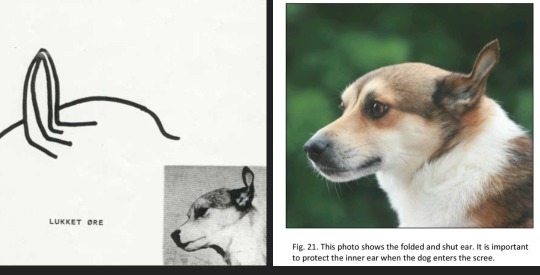
The standard:
Ears: Triangular ears of medium size, broad at the base, carried erect and very mobile. The cartilage of the ear lobe has the faculty of being able to retract itself so that the ear folds itself and flops in a specific manner, either backwards or in right angle upwards, so as to close the auditory passage.
Compendium addition:
The ears of the Lundehund have a unique muscle that enables them to fold and close the ears when entering the burrows, thus protecting them against dirt and moisture. The turning and folding of the ears probably also is help in locating the birds.

The standard:
Forelimbs: Moderately angulated. Forearm: Straight.
Forefeet: Oval shaped, turning slightly outwards, with at least six toes of which five must rest on the ground. Eight pads on each foot. The two inner toes, formed respectively by 3 and 2 phalanges and endowed with a ligamentary and muscular system, make the foot look solid.
Compendium addition:
Very flexible and elastic shoulder muscles. The Lundehund has joints that allow the forelimbs to extend at nearly 90 degrees from the body, but this must NEVER be demonstrated in the ring! The forefeet turn slightly outwards to give room for the extra toes.
The Norwegian Lundehund is a polydactyl. Instead of the normal 4 digits, the Lundehund normally has 6 digits, all fully formed, jointed and muscled, with tendons going up the inside of the leg, partly responsible for its wide front gait. Some specimen may have more, others less than 6 digits per foot, but less than 6 on front feet should lead to downgrading. The extra toes help the dog climbing up and down crevices in screes and cliffs.

The standard:
Hindfeet : Oval shaped, turned slightly outwards, with at least six toes - four of which must rest on the ground. Seven pads on each foot, the one in the middle, the most important one by its size, being attached to the inner pads corresponding to the two inner toes. When the dog is standing up on a flat surface, the weight of the body must be evenly distributed on the pads.
Compendium comment:
More than 6 digits is not a fault. 5 digits are acceptable on the hind feet. The extra toes on the hind feet are normally less developed than those on the forelegs and variations from the ideal, both regarding number and placement, should not be penalized.
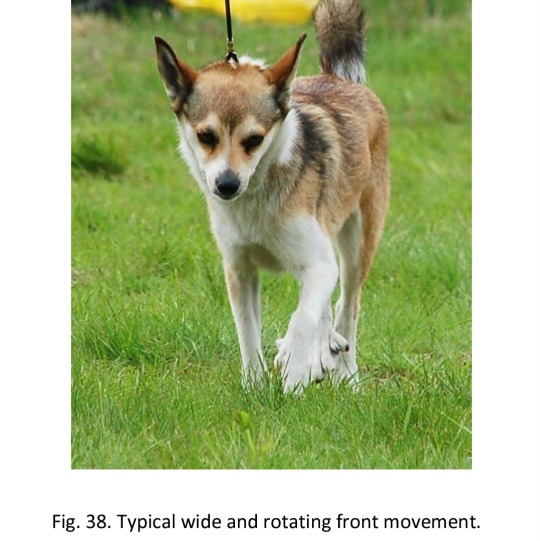
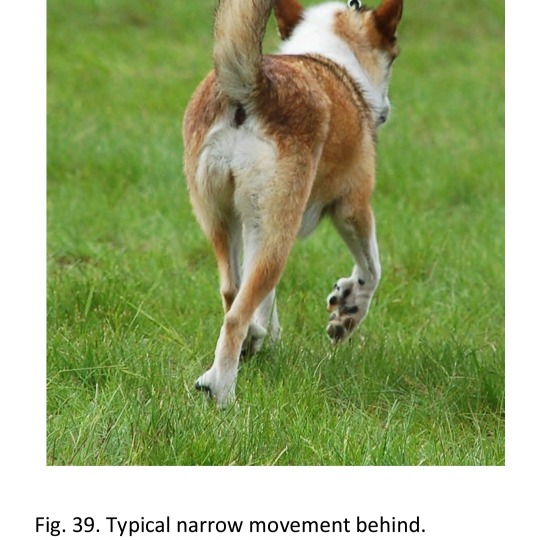
The standard:
Gait/Movement: Light and elastic. An external rotary action of the forelegs and somewhat close action behind is characteristic of the breed.
Compendium comment:
In judging the movements of the Lundehund, one must consider that this dog is built to climb efficiently up and down steep cliffs and screes. The extra pads on both fore- and hind paws must then touch the surface to aid the dog in climbing. The extra toes help getting a grip, both in ascent and descent. The wide front with extra flexibility enables climbing safely up and down crevices, as the forelegs can grip at a 90 degrees angle to the body. On flat surfaces, the Lundehund will show typical rotating front movements, due to tendons and muscles from the extra digits on the inside of the legs. Hind movements are narrow.
#norwegian lundehund#lundehund breed compendium#(excerpts)#photos from the compendium + the top from a veterinary journal on outcrossing#is2g every time i talk about this breed it sounds like youre making a fantasy species thats a Dog But Slightly Off#long post#some of these traits appear in other primitive breeds as well#lundehunds were described in 17th and 18th century texts. but we know there have been dogs in this area for thousands of years#plently long enough to produce a freak of nature (<3)
917 notes
·
View notes
Text
Wet Beast Wednesday: moray eels
This week on Wet Beast Wednesday I'll be going over something amazing, a fish with a sense of morality. You see, the moral eel is known for, what... I think I'm reading this wrong. Oh, MoRAY eel, not moral. Well this is awkward. Hang tight, I need to go redo my research.

(Image: a green moray (Gymnothorax funebris) swimming outside of its burry, with its whole body visible from the side. It is a long, slender fish that looks a bit like a snake. A long fin starts just below the head and continues down the length of the body. The body is arranged in a wave pattern. It has a pointed snout and small eyes. Its body is a yellow-green color. In the background is the sandy seafloor, dotted with various sponges and corals. End ID)
Moray eels are true eels, meaning they are in the order Anguiliformes. Yeah, I did wolf eels, electric eels, and lamprey eels before I got around to actual eels. There are over 200 known species of moray eel in 15 genera. Like other eels, they are elongated bony fish with extra vertebrae and reduced fins. Moray eels have fewer fins than most eel species, only having a dorsal, anal and tail fin that merge together and run down the back of most of the body and underneath portion of it. They achieve motion by undulating this long fin and sometimes undulating the rest of the body as well. Moray eels aren't the fastest of fish, but they can swim backwards, something almost no fish can. The head has a long snout with wide jaws. Most species have long fangs used to grab onto prey, but a few species are adapted to eat hard-shelled prey and have molar-like teeth to crush through shells instead. Probably the coolest feature of morays are the pharyngeal jaws. This is a second set of jaws located in the back of the mouth. When the eel bites onto prey, the jaws can be shot forward to grab the food and help pull it into the throat. While lots of fish have pharyngeal jaws, morays are the only ones who can extend their pharyngeal jaws forward and use them to grab prey. Morays have smooth, scaleless skin that is often patterned to provide camouflage. The skin is coated in mucus that provides protection from damage and infection. In some species, the mucus can be used to glue sand together to help reinforce burrows. Morays lack lateral lines, a system of organs found in most fish that senses changes in water movement. Their sense of smell is their primary sense. The size of morays varies between species. The smallest species is the dwarf moray eel (Gymnothorax melatremus) which reaches 26 cm (10 in) long. The largest species by mass is the giant moray eel (Gymnothorax javanicus) which can reach 3 meters (10 ft) and 30 kg (66 lbs) while the longest species is the slender giant moray (Strophidon sathete), the longest known specimen of which measured in at 3.94 m (12.9 ft).

New reaction image
(Image: a giant moray (Gymnothorax javanicus) emerging from a burrow. It is brown and mottled with yellowish patches. Its head is pointed at the camera and it's mouth is wide open, aming it look shocked. End ID)

(Image: an anatomical diagram of the skeleton of a moray eel emphasizing the pharyngeal jaws and the muscle attachments. End ID. Art by Zina Deretsky)
Moray eels are found throughout the Atlantic, Pacific, and Indian oceans. Different species are found in different temperatures and depths, though most species live in relatively shallow, warm water. Several species can live in brackish water and a few will swim upriver and live for a time in fresh water, though there do not appear to be any species that live their entire lives in fresh water. Morays are ambush predators who rely on the element of surprise. They live in small, tight places such as holes in coral, gaps between rocks, or sandy burrows. When prey passes, the eel can lunge out and grab it. Unlike most fish, the eel cannot use suction feeding due to the shapes of their mouths. They have to rely on lunging froward and catching prey with their mouths. Their mouths are adapted in shape to push water to the sides. This reduces water resistance and avoids creating a wave that could push prey away from the eel. If an eel catches prey that cannot be swallowed whole, it will tie itself in a knot while biting on to the food. By pulling its head through the loop, the eel can rip the food into bite-sized pieces. Spending most of their times in burrows also provides protection from predators, especially in juveniles or smaller species. At night, the eels will come out of their burrows to hunt sleeping prey while the larger predators are asleep. Giant morays have also been seen engaging in interspecies cooperative hunting with roving coral groupers (Plectropomus pessuliferus). The eels can fit into small crevices the groupers can't to flush prey into the grouper's path while catching their own. Morays are mostly solitary species and many can be territorial. They are known to be shy and will retreat into their burrows if they feel threatened. They are also curious and many species are quite intelligent.
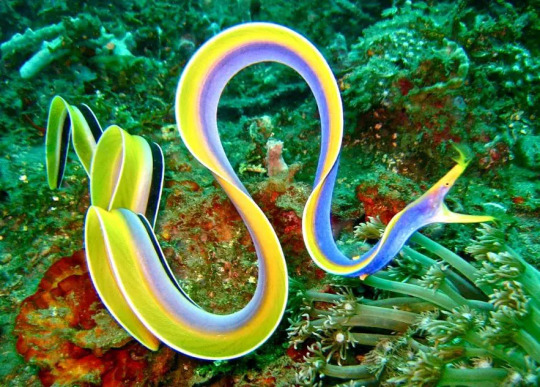
(Image: a male ribbon eel (Rhinomuraena quaesita) on a coral reef. It is a very long and slender eel with its body curved in many waves. It is brightly colored, with a blue-purple body, yellow fin and face, and a long black and white stripe running down the back half of the body. On the nostrils are two feather-like structures. End ID)
Morays reproductive strategies are poorly known and differ based on species. While many species seem to have no set mating season and will reproduce whenever they can, others will mate at the same time every year. Some species seem to have dedicated spots to lay their eggs and a few are believed to be anadromous, meaning they travel from the sea to fresh water to spawn. Meanwhile, some of the species that spend a lot of time in fresh water are catadromous, meaning they return to sea to mate. Females will lay their eggs and the male fertilize them. After this, they depart, providing no parental care. As with all true eels, moray eels begin life as leptocephalus larvae. This type of fish larvae is notable for its resemblance to a simple, transparent leaf with a head on one end. These larvae are unique and poorly understood, despite being the larval stage of a lot of different species of fish. They are unusually well developed for larvae, capable of active swimming and generally living life. In fact, some particularly large leptocephalus larvae were initially mistaken for adult fish. They feed mostly on bits of drifting organic material called marine snow and can remain in the larval stage for up to 3 years, with those in colder conditions usually taking longer to metamorphose. All leptocephalus larvae start out with no sex organs, then develop female organs, then develop male ones, becoming simultaneous hermaphrodites. They will ultimately become eith male or female and it is likely that environmental factors are the main determining factor. During metamorphosis into a juvenile, the leptocephalus can reduce in size by up to 90%, resulting in the juvenile being smaller than the larva. The process of maturation is poorly understood, but it seems that most morays will be sexually mature by three years of age.

(Image: multiple photos of a particularly large leptocephalus larva (not sure what species). It is a translucent organis, wth a body shaped like a very long leaf, narrow at both ends. In the frint is a very tiny head. End ID)
Morays are shy and generally avoid humans. Though some cultures have hunted them for food, they are often not considered a particularly good food source. Many species have high levels of chemicals called ciguatoxins in their bodies, which can lead to a condition called ciguatera fish poisoning if eaten. The largest threat to morays is habitat loss. This is especially true for the many species that live in coral reefs, which are in increasing danger due to global warming. Attacks on humans are rare and usually happen as a response to a human sticking their hand in the eel's burrow. Some of the large species could cause significant damage with a bite. Some species, usually the smaller ones, are found in the aquarium trade, thought they are not good pets for beginners as even the smallest morays are still large for aquarium fish and have some specific requirements. The curiosity many morays have has led to some becoming familiar with and even friendly to humans, often the result of feeding them. They can recognize individual humans and remember them over the course of years. Aquarium employees sometimes report that the eels will come to nuzzle and play with them and have personalities like dogs. Marine biologists and professional SCUBA divers Ron and Valorie Taylor befriended a pair of eels they named Harry and Fang at the Great Barrier Reef who would remember them and come out to visit them year after year.
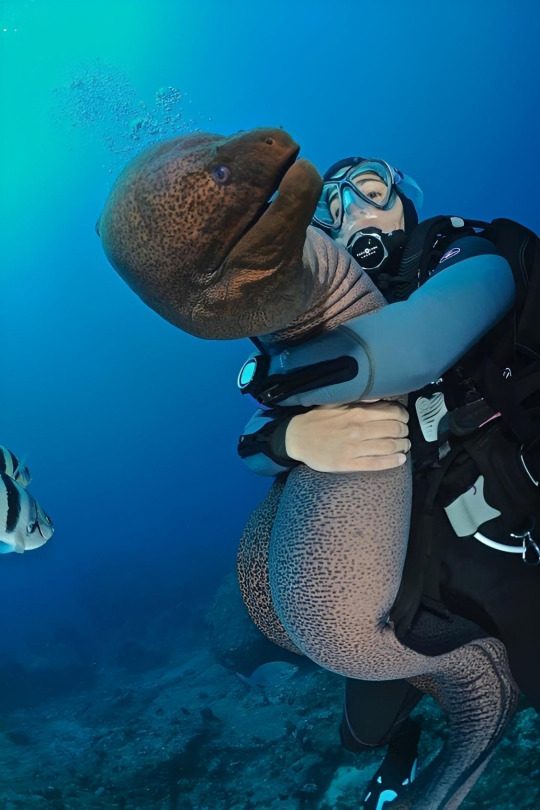
(Image: a SCUBA diver hugging a large, brown moray with black spots. End ID)
youtube
(Video: A shot video showing Valeria Taylor and a moray eel she befriended)
youtube
(Video: the song "That's a Moray", a parody of the song "That's Amore" by Dean Martin)
#wet beast wednesday#i accidentally typed moron eel more than once#moray eel#eel#anguiliformes#fish#bony fish#fishblr#fishposting#eelposting#marine biology#biology#ecology#zoology#animal facts#informative#image described#that's a moray#educational#Youtube
1K notes
·
View notes